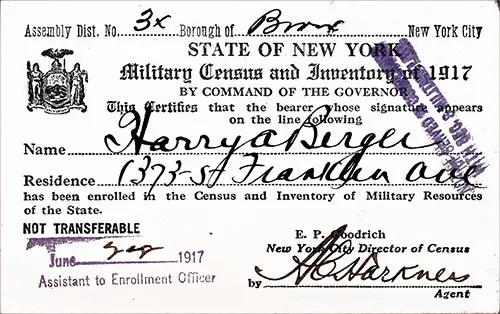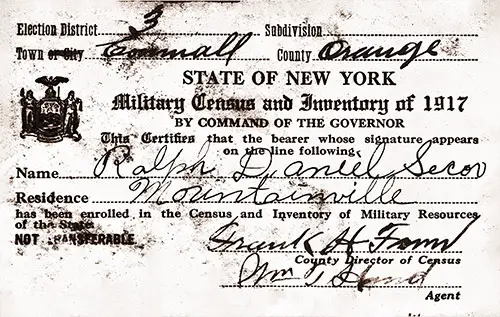State of New York Military Census and Inventory of 1917

Wallet-Sized Military Census and Inventory of 1917 Card for Harry A. Berger, Assembly District No 3X, Burough of Bronx, New York City Dated 22 June 1917. GGA Image ID # 182274c4a0
Military Census and Inventory of 1917 State of New York. World War One Military Census and Inventory of 1917, State of New York. Issued to Ralph Daniel Secor of Mountainville, New York in Election District 3, Town of Cornwall, County of Orange.
This Certifies that the Bearer Whose signature appear on the line follow
Name: Harry A Berger
Residence: 1373 S Frankln Ave
has been enrolled by the Census and Inventory of Military Resources of the State.
June 22, 1917

Wallet-Sized Military Census and Inventory of 1917 Card for Ralph Daniel Secor, Election District No 3, Town of Cornwall, Orange County, New York, nd, circa 1918. GGA Image ID # 1847e16c38
All residents of the State of New York from the ages of 16 to 50 were required to fill out the questionnaire. * When the work was first planned it was expected that the State would be asked to give a list of the men available for the draft, and accordingly one set of blanks covered men from 21 to 30 years of age, and was printed in red, in order that it might he readily segregated from the others. The Federal draft, however, made this work unnecessary.
The list of questions and the order in which they were listed required weeks of study in order that the greatest amount of accurate information might be secured with a minimum of trouble and misunderstanding.
Age
The most important factor was age, and in order that this might be checked the first requirement was the exact date of birth.
Address
The next point of importance was the address of each individual. As a further check and in order to readily locate the men and women of a given occupation, the name of the present employer, his address and business were called for by the blank.
Country of birth
If the individual was not born in the United States, he or she was requested to give his or her country of birth. This involved considerable discussion as to the countries which should be tabulated, and it will be seen from the form which countries were selected. For obvious reasons, the length of time the individual had lived in the United States and the length of time he had been a resident of the State of New York was also required.
Citizenship
In connection with citizenship, the question was asked whether or not the individual was a citizen of the United States, and if so, whether by birth or naturalization. The date of naturalization was also required. If not a citizen, the question “Were first papers taken out?” was to be answered. If not a citizen of the United States, the blank asked of what country the individual was a citizen or subject. It was recognized that the country did not exactly determine citizenship. There were persons born in England, France, Germany, etc., who were citizens of the United States because their parents were citizens of this country.
Parents’ birthplace
In the event that the question of the country in which the parents were born ever became a factor in determining a man’s availability for military service, it was decided to insert a question 'covering the parents’ birthplace.
Availability for military service.
It should be borne in mind that this census was primarily a military census, and that being so it was important to determine the number of dependents in each individual case. Accordingly a question was embodied in the blank to show whether or not a man was married, whether or not his wife was living and how many persons including father, mother, wife or children, sister or brother were entirely dependent upon him for support.
Education
The educational section of the census was divided into four parts, those who had attended (1) Elementary School (2) High School (3) Technical School (4) College. This was intended to enable the authorities quickly to segregate those who had technical education.
Languages
As a knowledge of languages was of value to the military authorities, the blank was so arranged that those who either spoke another language than English, or those who had acted as interpreters of any foreign language, could be tabulated separately.
Trades, occupations or professions
In order to determine the availability of residents of New York State for military' service, it was necessary not only to ascertain their trades, occupations or professions, but to find out as well whether they held any public office under the National or State governments which would exempt them from conscription.
Former occupations
It was deemed desirable to ascertain the exact nature of the trades or callings formerly followed; since it might easily happen that a man now following an occupation which was not essential to the prosecution of the war might have had training in some other trade which would make him a very valuable man for military service.
A tabulation of the occupational section of the census is an exceedingly difficult one and accordingly the questions had to be framed with great care. The magnitude of this work can best be judged from the fact that the Federal Census Bureau prepared a list of 17,000 occupations and sub occupations in connection with the census of 1910, but only one-third of the cases came directly within this lengthy list.
In the case of the present census, the exact occupations in many instances were not of special interest to the Government; many of them were grouped; others were handled individually, because they seemed of vital importance to the State in time of war.
Foreign business connections
The question was asked, “Have you ever acted as agent or otherwise for any foreign country, dealer or merchant?” The purpose of this question was two-fold, first, to obtain a list of men who had had experience in business dealings with other countries, since their services in that case would he of great value to the United States; and second, to obtain a list of foreigners who might endeavor to keep up secret relations with the enemy country.
Military or naval service
Every man between the ages of 16 and 50 was asked to give an account of his military or naval service, military or naval training at school, college or on cruise. He was also asked to state whether he desired to enlist in the United States Army, Navy, Marine Corps, National Guard or Naval Militia. This list has been used extensively already by the government.
Accomplishments
Under this heading were recorded persons who were able to drive automobiles, manage power boats, run steam engines or stationary engines and also those who could use a telegraph instrument or a wireless outfit.
Special occupations
The Federal Government was anxious to obtain men who were schooled in shipbuilding and those who were navigators or pilots. Accordingly all men were asked if they had ever been employed in shipbuilding, and if so, in what capacity, and if they were navigators or licensed pilots.
If the census were to be taken again, a number of changes would be made. Greater details of certain occupations would be required and the willingness of the workers in certain occupations to be transferred to another section of the country would be determined. Furthermore, if any other state now wished to take a similar census, much of this could be eliminated because the Federal Registration has given information on men from 21 to 30.
Women
The principal information desired from women was along the same line as that for men, with regard to age, residence, nationality, citizenship, place of employment, education and knowledge of foreign languages.
With regard to their availability for military service, however, different information was desired. They were asked whether they were registered nurses, practical nurses, had had experience in surgical cases, had completed courses in training in first aid, had worked under the Red Cross, or had made hospital supplies. Information was also required as to their ability to drive automobiles.
As there was great demand in commercial and government departments for the services of women, it was deemed advisable to obtain information as to the number who could operate typewriting machines, take shorthand, operate telephone switchboards or telegraphic instruments, or do general telegraphic work.
At the time the census was taken it was evident that there would be a demand for women able to do agricultural work and sewing for the soldiers and sailors and the destitute in Europe. Information was accordingly obtained on these subjects.
"Military Census and Inventory," Based on the Questionnaire for Males and Females, State of New York, The Adjutant General's Office, Military Census Bureau, in The New York State Military Census and Inventory: A Report to Hon. Harles S. Whitman, Governor of the State of New York, Albany: J. B. Lyon Company, 1917, pp. 14-21. The Card Above is the Result of Completing the New York Military Census and Inventory Questionaire.
